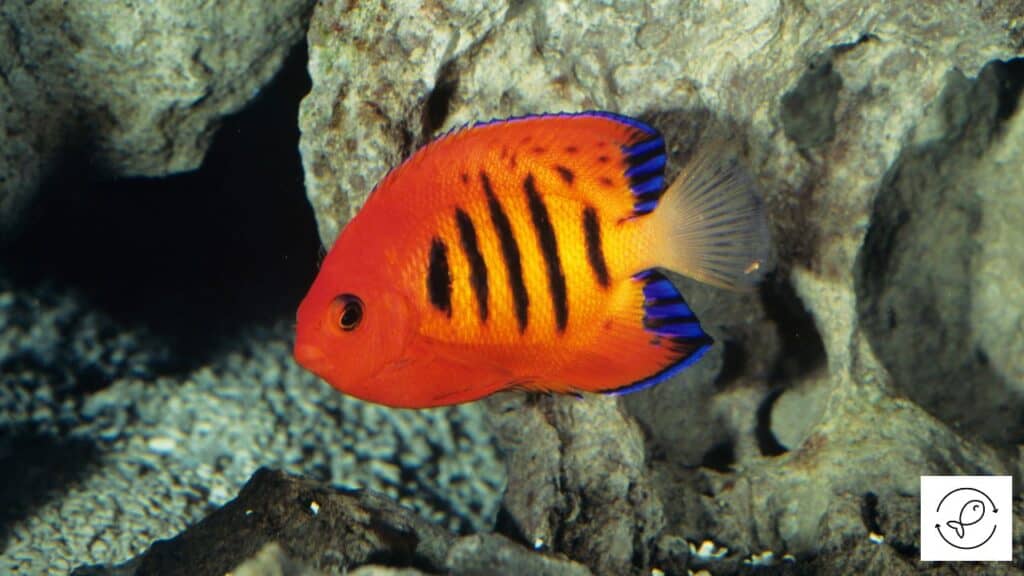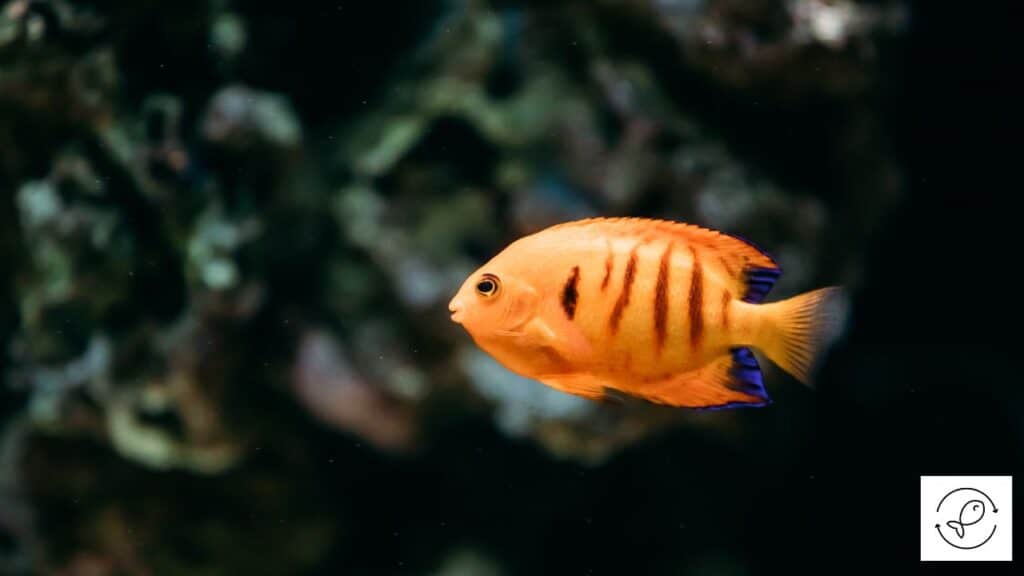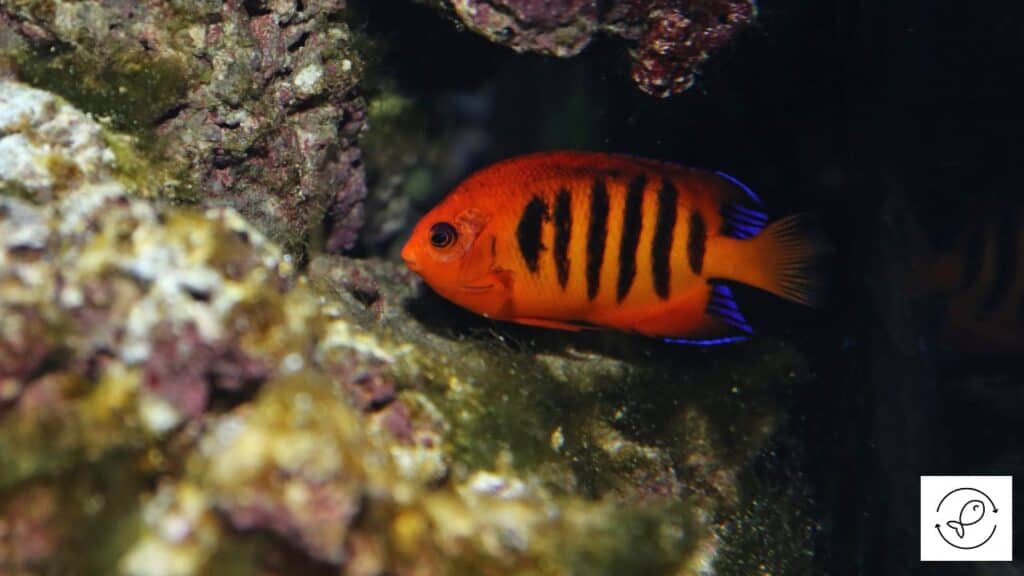The flame angelfish is an exotic marine fish species.
These vibrant and gorgeous saltwater fish are a popular choice for marine aquariums.
Although flame angelfish are easy to care for, they need a conducive environment to thrive.
So let’s learn about flame angelfish in more detail.
Flame Angelfish Species Overview
Flame angelfish (Centropyge loricula) belong to the family Pomacanthidae and the genus Centropyge.
They’re also known as flame angels, flaming angelfish, and Japanese pygmy angelfish.
You will find them in the tropical waters of the Indo-Pacific ocean.
These fish are native to various reefs in Oceania and are commonly found in the Marshall, Line, and Cook islands.
They’re bottom-dwellers that live on the slopes of coral reefs and lagoons.
Flame angelfish are also referred to as the “pearls of the reef basin” for their stunning color.
Besides having a beautiful color, they also have a peaceful nature and can cohabitate with other fish species.
Appearance

Flame angelfish resembles a real flame.
The blazing red color of this fish enhances its visual appearance making it a popular choice for marine aquariums.
A flame angelfish has an orange-red body with a vertical elongated dark spot and four to five horizontal stripes on the sides.
Males tend to be bigger and more colorful than females.
A black line with a bluish-purple tint runs around the posterior part of the anal and dorsal fins.
The pelvic fins have a deep orange color.
Lifespan
Flame angelfish have a lifespan of 5 to 8 years in a captive environment.
These fish have an average lifespan of 6 years or a little longer in the wild.
Keeping them in pristine water conditions can also improve their lifespan.
So maintaining ideal water parameters and proper maintenance is essential.
Flame angelfish are easy to handle. They’re also generally good eaters.
So an adequate and well-balanced diet can increase their longevity.
However, ensure that you remove any leftover food to avoid toxic buildup in the water.
Average Size
In their natural habitat, flame angelfish can grow up to 6 inches in length.
In captivity, the average size of a fully grown flame angelfish is between 4 to 6 inches.
Males are slightly bigger compared to females. However, the size difference is barely noticeable in this fish species.
The size of the tank is critical for keeping these fish.
Although flame angelfish are small, they’re active swimmers and need plenty of swimming space.
Flame Angelfish Tank Setup

Flame angelfish are usually considered reef safe.
So these fish can quickly adapt to a captive environment and will not consume or damage the soft or stony corals.
Let’s now understand how to set up the fish tank for flame angelfish.
Tank Size
Flame angelfish are small in size but need plenty of swimming space.
The minimum tank size for a single flame angelfish is 30 gallons, but it’s best to provide them with more space to avoid aggressive behavior.
Flame angelfish are mostly peaceful but can become territorial and compete with other fish for food.
So keeping them in a larger tank of 75 to 100 gallons is recommended.
Flame angelfish enjoy exploring all crevices for hidden morsels of food.
Moreover, having abundant caves can also relieve your other fish from the occasional pursuit.
Tank Equipment and Decorations
Flame angelfish like to spend much of their time closer to the substrate, grazing on live rocks.
So it’s best to create an environment that mimics their natural habitat.
Choose between a sandy or gravel bottom for the substrate.
It can provide flame angelfish with a good option for laying eggs during breeding.
Flame angelfish are shy and like to stay hidden.
So live rocks of different shapes and sizes can be used while setting up the marine aquarium.
Adding coral reefs can help in creating a natural environment.
You can also include logs, bushes, flower pots, and caves to provide plenty of cover for grazing and shelter.
Moderate lighting is best to keep these fish happy. Besides, soft coral can easily grow under low lighting conditions.
Given below are the items required in a flame angelfish tank:
- Substrate (gravel or sand),
- Filter,
- Heater,
- Moderate lighting,
- Saltwater plants like green finger algae, halimeda, mermaid’s fan, dragon’s tongue algae, etc.,
- Thermometer,
- PH testing kit, and
- Hiding places like live rocks with crevices, caves, driftwood, etc.
Regular maintenance is essential to keep the water parameters within the required limit.
This will ensure that your fish feel comfortable and happy.
Flame Angelfish Care

Flame angelfish are among the most popular species of angelfish that are well known for easily adapting to marine aquariums.
However, these fish still need proper care and attention to flourish.
Diet
Flame angelfish are omnivores that primarily feed on algae.
However, they’re also known to eat tiny animals living inside the algae. Therefore, it’s essential to feed them a well-balanced diet.
These fish graze around the crevices and substrate, primarily eating algae.
In addition, you can feed them meaty food to satiate their protein requirement.
It’s important to keep their diet diverse by mixing different types of marine algae, spirulina, and algae-based flakes and pellets.
Keep live rocks in the tank to encourage natural algae growth.
Feed your flame angelfish a small amount of food several times a day.
Young fish should be fed up to 4 times daily to support their growth.
Remove leftover food to avoid nitrate and other toxic buildups.
Some of the live food that you must feed your flame angelfish are:
- Brineshrimp,
- Mysis shrimp,
- Clams,
- Mussels,
- Squid, and
- Krill.
You should only offer them the amount of food that they can eat within one or two minutes.
Also, ensure a proper mix of plant and meat-based food for their overall well-being.
Water Parameters
Flame angelfish are saltwater fish. They’re hardy and can survive some variation in the water conditions.
These fish like warmer temperatures as they belong to the warm tropical waters.
So it’s best to replicate the water conditions of their natural habitat.
The ideal water parameters for flame angelfish are:
| Water Temperature | 72°F to 78°F (22°C to 26°C) |
| Water pH | 8.0 to 8.4 |
| Specific Gravity (Salinity) | 1.020 to 1.025 |
| Water Hardness (dKH) | 8 to 12 |
Tank Maintenance
Flame angelfish are easy to look after, but if they aren’t given enough attention, they may not thrive.
Aquariums need regular maintenance to ensure proper water conditions.
These fish are less sensitive than other species but need favorable water conditions to thrive.
A water change of 30% per month or 15% every two weeks can keep nitrate levels in check.
If you want corals in the tank, then 20% water change every month, 10% every 2 weeks, or 5% every week is required.
Regular water testing is also essential to determine the maintenance cycle.
Common Diseases
Flame angelfish can handle varying water conditions.
However, these fish are susceptible to diseases if exposed to poor tank conditions.
Given below are a few of the common diseases that can affect flame angelfish:
- Saltwater Ich,
- White Spot,
- Marine Velvet,
- Cotton Wool,
- Vibrio Bacterial,
- Fish Tuberculosis,
- Fungal infections, and
- Bacterial infections.
As with the other fish species, the marine aquarium needs to be appropriately maintained for flame angelfish to thrive.
Flame Angelfish Behavior and Temperament
Flame angelfish are primarily peaceful and can coexist with other tankmates.
However, these fish can get stressed in specific situations and resort to aggressive behavior.
The tank size and the available space are the most significant factors when it comes to the behavior and temperament of flame angelfish.
If the space is limited, these fish can become territorial and guard their territory against other fish.
A medium-sized tank with only one or a few caves is unsuitable for keeping more than one flame angelfish.
So to keep multiple flame angelfish, you will need to add more live rocks, change the tank’s size, or rework the existing tank.
The objective is to create multiple territories inside the tank.
Doing so will allow your fish to roam freely throughout the aquarium without having to guard their territory.
Flame Angelfish Tankmates

Flame Angelfish have a calm personality and get along well with other fish.
These fish usually prefer to live in pairs or small groups, which means they don’t want to be left alone.
Flame angelfish should be housed in an aquarium with lots of hiding spots for them to feel comfortable.
These fish take some time to adjust to their new environment.
Some of the tankmates that you can keep with flame angelfish are:
- Anthias,
- Clownfish,
- Tangs,
- Wrasses, and
- Large shrimp.
Avoid keeping tankmates that are docile or submissive.
Furthermore, angelfish are aggressive toward their species and other fish species that look similar.
Also, avoid keeping them with large, aggressive fish species as they can get stressed or become a snack for the aggressive fish.
Given below are some fish that shouldn’t be kept with flame angelfish:
- Flame Angelfish (multiple male fish),
- Clown Tigerfish,
- Three Stripe Damselfish, and
- Small Shrimp.
Flame angelfish can be kept with other fish species that are similar in size and temperament.
However, ensure that there is plenty of swimming space for all the tank inhabitants.
Breeding Flame Angelfish
Like most marine fish, flame angelfish are known as protogynous hermaphrodites.
It means they’re born as females, but social dynamics result in the dominant fish changing its gender to male.
So it’s best to obtain a young pair and raise them together in a large tank.
Eventually, the fish will become familiar, and the more dominant fish will mature into a male.
To encourage breeding, keep the water temperature between 80°F to 82°F and feed them a healthy diet.
Provide them plenty of vertical space and remove any tankmates that can startle them.
Once the flame angels are ready for breeding, the male fish will seek the female just before the lights go off.
During this time, the male will start chasing the female around the tank.
If the female responds, they will swim together toward the surface of the water, stopping before reaching the top.
They will repeat this ritual until they spawn.
Move the eggs to a new tank for raising the fry.
Be cautious and bring little water from the established tank as it can contain copepods that can attack the eggs and fry.
Depending on the water temperature, the eggs will hatch in 16 to 20 hours.
Feed the hatchlings with microalgae to provide the required nutrition.
Flame Angelfish Scientific Classification
| Kingdom: | Animalia |
| Phylum: | Chordata |
| Class: | Actinopterygii |
| Order: | Perciformes |
| Family: | Pomacanthidae |
| Genus: | Centropyge |
| Scientific Name: | Centropyge loricula |
| Also Known As: | Flame Angelfish, Flame Angel, Flaming Angelfish, Japanese Pygmy Angelfish |
| Conservation Status: | Least Concern |

